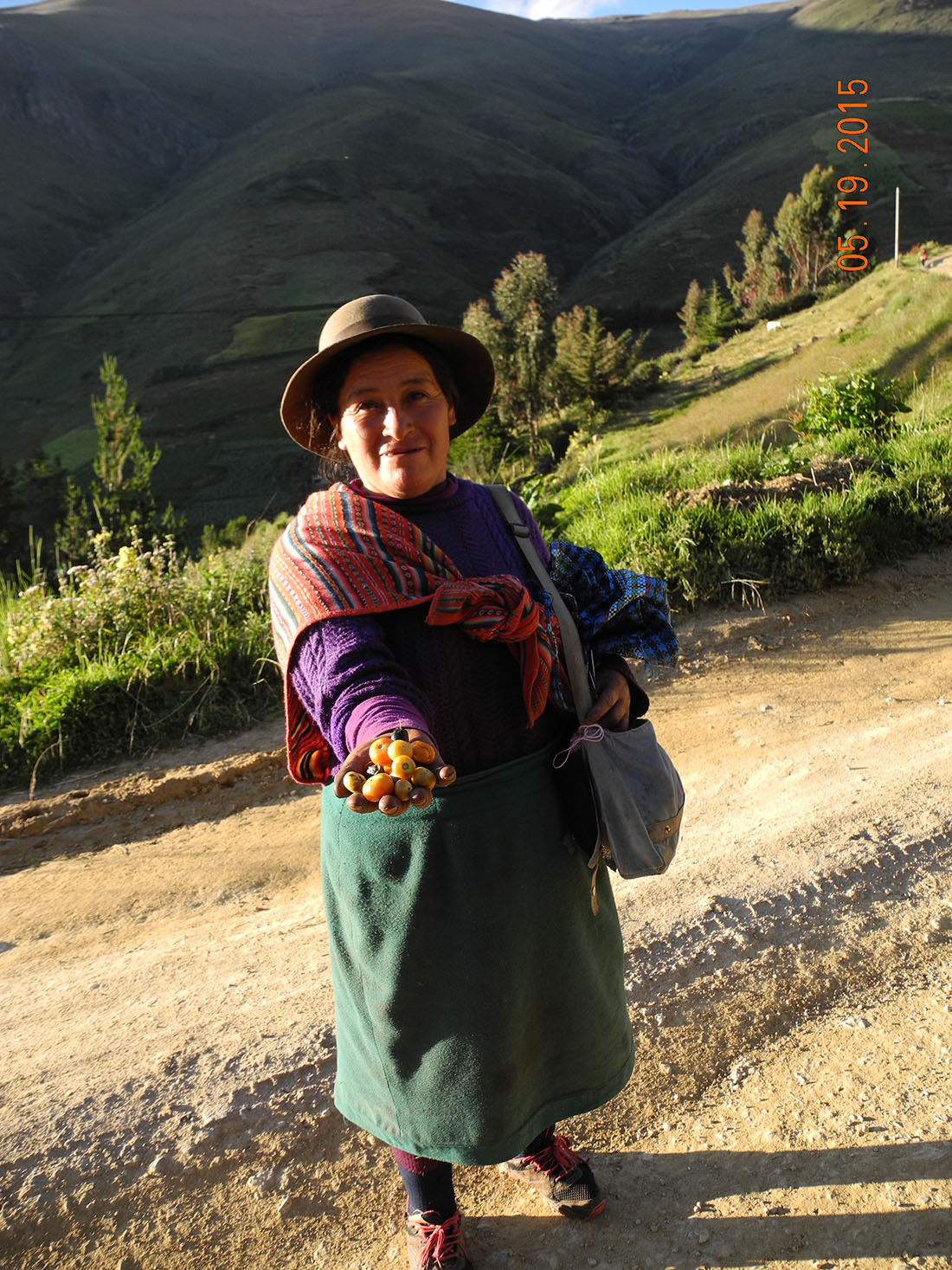
Mione et al. 862, photo by T. Mione in Peru
Jaltomata weberbaueri (Dammer) Mione |
Peru |
revised Aug 2023 |
| Link to Jaltomata homepage | The information on this page may be cited as a communication with professor Thomas Mione, Central Connecticut State University, Biology Department, Copernicus Hall, 1615 Stanley Street, New Britain, Connecticut 06050-4010, United States of America. | Novon 2: 383-384. 1992 |
Link to the Jaltomata Ancash, Peru |
Link to Jaltomata having red nectar |
Link to the Jaltomata of northern Peru |
Link to local names including of this species |
Link to list of Jaltomata species having edible fruits,
including this species |
| Figure 1, above. Flower of Jaltomata weberbaueri, Mione et al. 862, photo by T. Mione in Peru |
| Figure 2, above. Flower and ripe fruits of Jaltomata weberbaueri, Mione et al. 862, units along bottom are mm, photo by T. Mione in Peru |
 |
| Figure 3, above. Ripe fruits of Jaltomata weberbaueri in the hand of a woman passing by. We asked her if there are any uses of this plant, and she responded by showing us the fruits she was carrying in her pocket. She said fruits are eaten by nearly all the locals. Mione et al. 862, photo by T. Mione in Peru |
Table 1. Geographic and Altitudinal Distribution:
Peru, all specimens from Department Ancash, elevation 2,800 - 3,793 m; flowering in January, March, April, May and June.
| Province | Locality |
elev-ation m |
habitat |
date |
collector |
habit |
| see comment above | TYPE LOCALITY: Ocros | 3,400 | grupos de arbustos cerca de riachuelos | 27 Mar 1903 |
A. Weberbauer 2657 (Lectotype: MOL!; Isolectotype: G!; photo of B sheet, destroyed, F neg. 2558, WIS!) | |
| Aija | Cuchu Cuchu, entre Huamanwilca y Sequipoquian (spellings of place names?) | 3,400 | no data | 23 Apr 1983 |
C. Ochoa & A. Salas 15160 (NY) | |
| Aija | 3.5 km before Aija town, Recuay to Aija road, 9 46 19 S, 77 34 33 W | 3,793 | roadside | 14 Jun 2005 |
T. Mione, S. Leiva G. & L. Yacher 725 (US); S. Leiva G., T. Mione & L. Yacher 3361. |
shrub |
| Aija | about 10 min before city/town of Aija, Recuay to Aija road, 9 46 24.5 S, 77 34 51.1 W | 3,700 - 3,799 | roadside | 19 May 2015 |
T. Mione, S. Leiva G. & L. Yacher 862; S. Leiva G., T. Mione & L. Yacher 5890. |
shrub |
| Recuay | km 107 between Recuay & Pativilca | 3,300 | moist ravines | 30 Jan 1983 |
M. Dillon et al. 3174 (BH, GH, NY, US) | shrub to 2 m |
| Recuay | Bosque de Pararín | 2,800-3,000 | bosque | 24 May 1988 |
A. Cano 1900 (NY) | |
| Bolognesi | km 110.8 ruta Pativilca-Recuay | 3,400 | ladera entre Urtica sp. y J. aijana | 18 Jan 1998 |
T. Mione, S. Leiva G. & L. Yacher 626; S. Leiva G., T. Mione & L. Yacher 2135 (HAO) |
Leiva wrote "hierba" |
| Figure 4, above. Flowers of Jaltomata weberbaueri, Mione et al. 862, photo by T. Mione in Peru |
| Figure 5, above. Woody stem of Jaltomata weberbaueri, Mione et al. 862. Smallest units are mm. Photo by T. Mione in Peru |
| Figure 6, above. Ripe frutis of Jaltomata weberbaueri, Mione et al. 862. Units along bottom are mm. Photo by T. Mione in Peru |
| Figure 7, above. Flower of Jaltomata weberbaueri, Mione et al. 862. Units along bottom are mm. Photo by T. Mione in Peru |
| Novon 2: 383-384. 1992. Lectotypification see Mione & Granda P. (2006) Saracha weberbaueri Dammer, Bot. Jahrb. Syst. 37: 638. 1906. In the protologue the type locality is given as “Ocros, dep. Ancachs, prov. Cajatambo…3400 m.” On modern maps Ocros is the capital town of the province Ocros, at the south end of the department of Ancash, while province Cajatambo is at the north end of the department of Lima, just south of the department of Ancash. |
| Figure 8, above. Flower of Jaltomata weberbaueri, Mione et al. 862, photo by T. Mione in Peru |
| Figure 9, above. Flower of Jaltomata weberbaueri, Mione et al. 862, photo by T. Mione in Peru |
| Figure 10, above. Where two sepals meet a keel forms outward (upward in this photo because the flower is laying on its side). Jaltomata weberbaueri, Mione et al. 862, photo by T. Mione in Peru |
| Figure 11, above. Flower of Jaltomata weberbaueri, Mione et al. 862, photo by T. Mione in Peru |
|
Figure 12. Anthers of dorsal face on left, mm rulings showing vertically on left and right
Photo by Thomas Mione, Mione et al. 725 Anthers had been in 70% ethanol for years prior to photo being taken. |
|---|
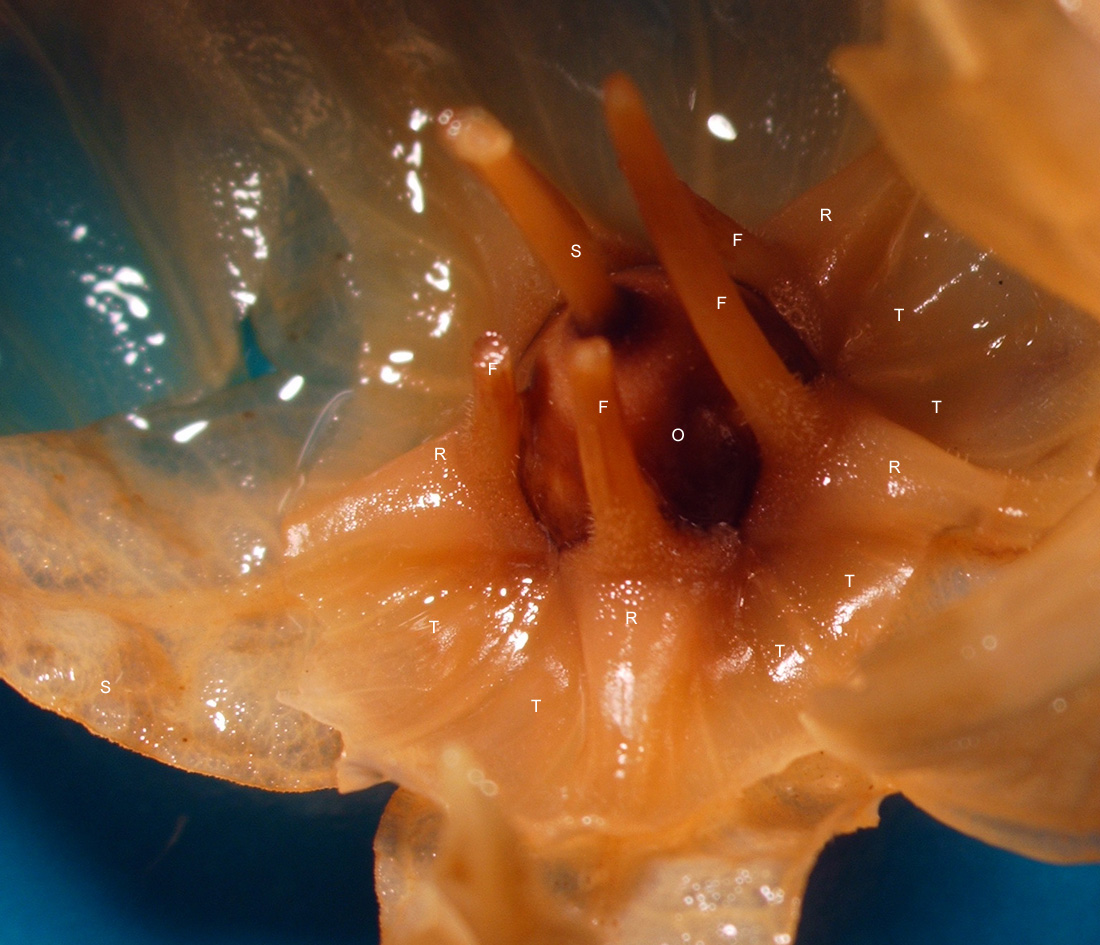 |
| Figure 13. Flower of Jaltomata weberbaueri. F, filament. O, ovary. R, radial thickening. T, nectar trough. Flower was stored for years in 70% ethanol prior to photo. Distal corolla tissue was removed during dissection. Photo by Thomas Mione, Mione et al. 725. |
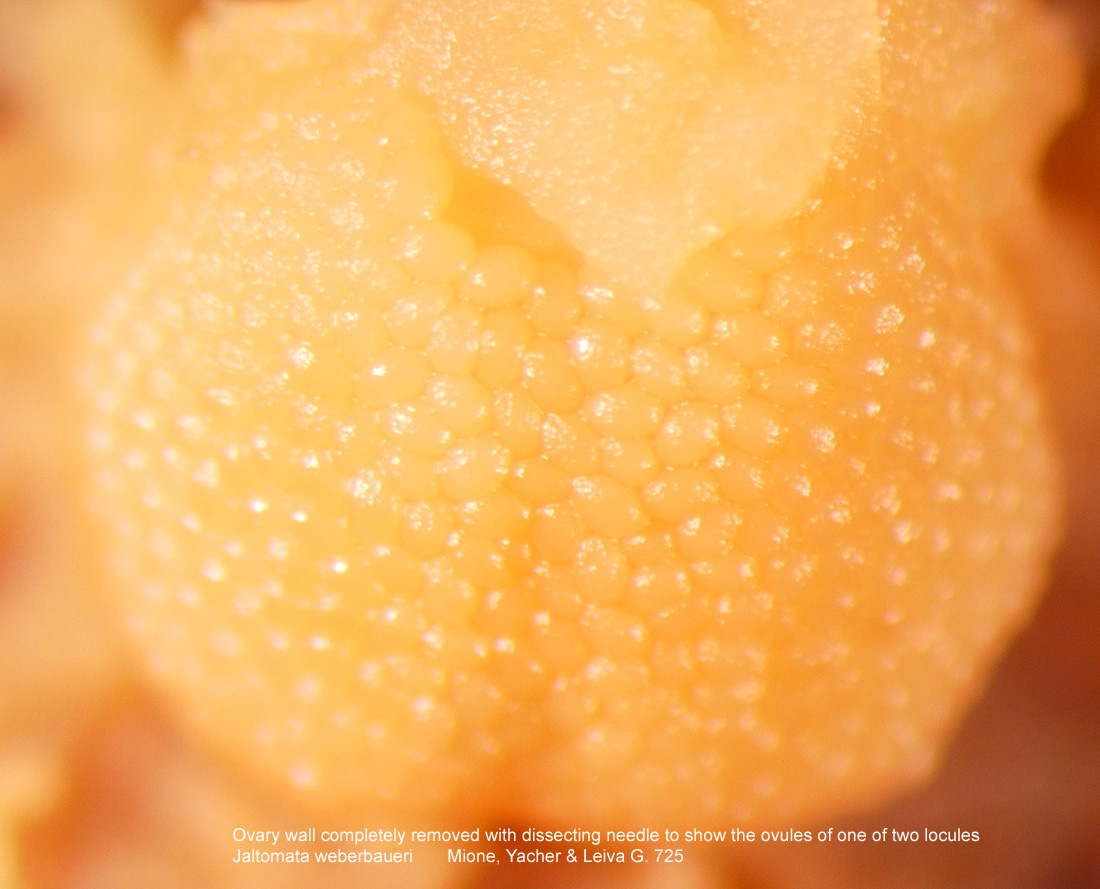 |
| Figure 14. The ovary wall was removed with a dissecting needle to show the ovules of one of the two locules of Jaltomata weberbaueri. 360 ovules were counted in one locule by slowly and carefully removing them with a fine dissecting needle. Dissection, counting and photo by Thomas Mione, Mione et al. 725. The ovary was stored for years in 70% ethanol prior to photo. |
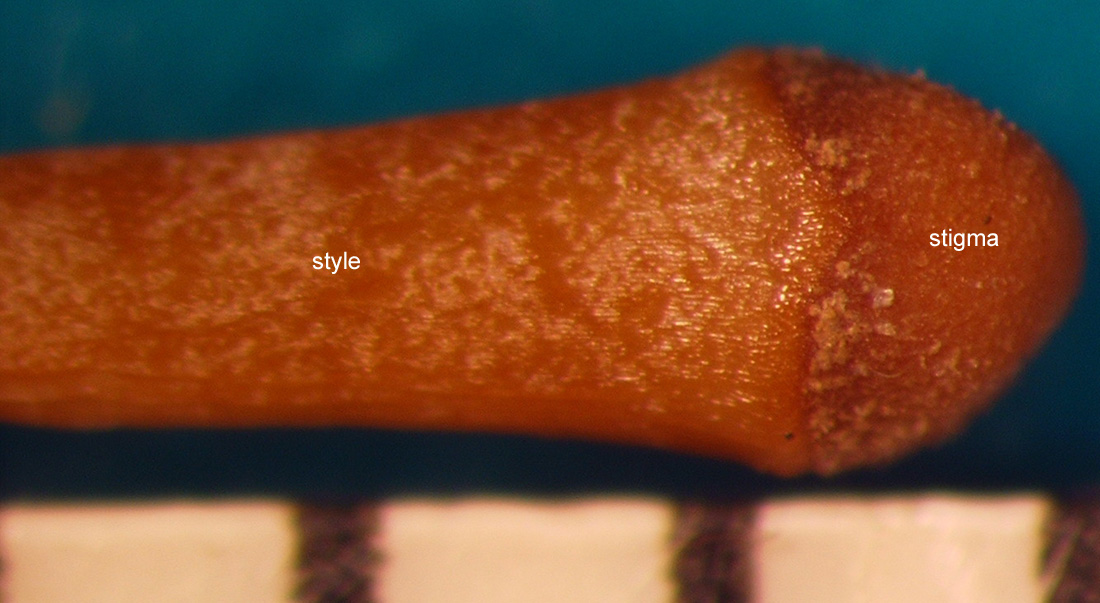 |
| Figure 15. Stigma and distal end of style of Jaltomata weberbaueri. Units (horizontally, out of focus) are mm. Flower was stored for years in 70% ethanol prior to photo. Photo by Thomas Mione, Mione et al. 725. |
| Figure 16, above. Flower on left shows both undehisced anthers and at least one dehisced anther. Jaltomata weberbaueri, Mione et al. 862, units along bottom are mm, photo by T. Mione in Peru |
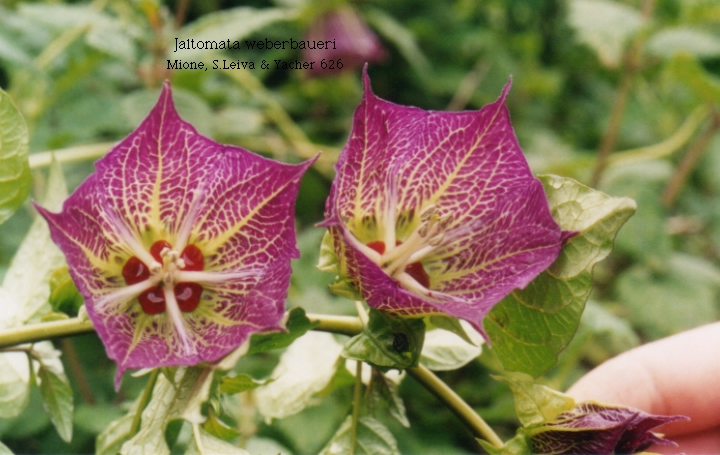 |
Figure 17. The corolla on the Note the red-orange Jaltomata weberbaueri photo by Segundo |
Figure 18. Jaltomata weberbaueri Radial thickenings,
The orange-red juice at the photo by T. Mione |
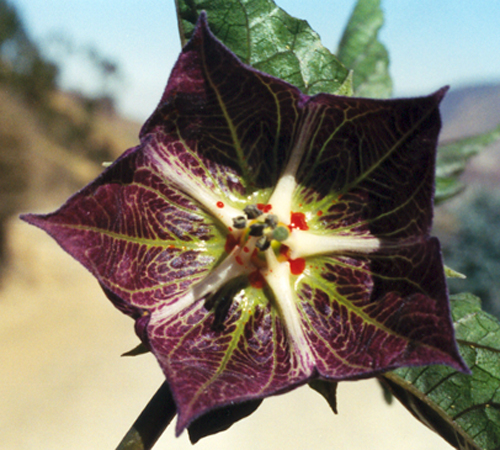 |